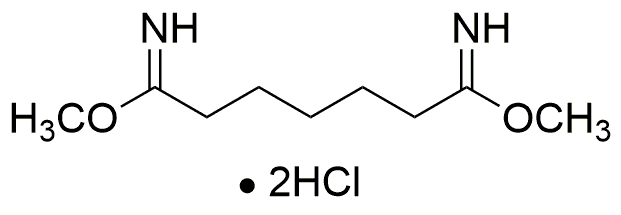Dimethyl pimelimidate dihydrochloride is widely utilized in research focused on:
- Protein Cross-Linking: This chemical is commonly used to cross-link proteins in biochemical studies, enhancing the understanding of protein interactions and structures.
- Vaccine Development: It plays a crucial role in the formulation of vaccines by stabilizing antigens and improving immune responses, making it valuable in immunology research.
- Bioconjugation: Researchers use it for bioconjugation processes, attaching biomolecules to surfaces or other molecules, which is essential in creating targeted drug delivery systems.
- Cell Culture Applications: It is employed in modifying surfaces for cell culture, promoting better cell adhesion and growth, which is vital for tissue engineering and regenerative medicine.
- Diagnostic Assays: This compound is utilized in the development of diagnostic assays, enhancing the sensitivity and specificity of tests used in clinical laboratories.
General Information
Properties
Safety and Regulations
Applications
Dimethyl pimelimidate dihydrochloride is widely utilized in research focused on:
- Protein Cross-Linking: This chemical is commonly used to cross-link proteins in biochemical studies, enhancing the understanding of protein interactions and structures.
- Vaccine Development: It plays a crucial role in the formulation of vaccines by stabilizing antigens and improving immune responses, making it valuable in immunology research.
- Bioconjugation: Researchers use it for bioconjugation processes, attaching biomolecules to surfaces or other molecules, which is essential in creating targeted drug delivery systems.
- Cell Culture Applications: It is employed in modifying surfaces for cell culture, promoting better cell adhesion and growth, which is vital for tissue engineering and regenerative medicine.
- Diagnostic Assays: This compound is utilized in the development of diagnostic assays, enhancing the sensitivity and specificity of tests used in clinical laboratories.
Documents
Safety Data Sheets (SDS)
The SDS provides comprehensive safety information on handling, storage, and disposal of the product.
Product Specification (PS)
The PS provides a comprehensive breakdown of the product’s properties, including chemical composition, physical state, purity, and storage requirements. It also details acceptable quality ranges and the product's intended applications.
Certificates of Analysis (COA)
Search for Certificates of Analysis (COA) by entering the products Lot Number. Lot and Batch Numbers can be found on a product’s label following the words ‘Lot’ or ‘Batch’.
*Catalog Number
*Lot Number
Certificates Of Origin (COO)
This COO confirms the country where the product was manufactured, and also details the materials and components used in it and whether it is derived from natural, synthetic, or other specific sources. This certificate may be required for customs, trade, and regulatory compliance.
*Catalog Number
*Lot Number
Safety Data Sheets (SDS)
The SDS provides comprehensive safety information on handling, storage, and disposal of the product.
DownloadProduct Specification (PS)
The PS provides a comprehensive breakdown of the product’s properties, including chemical composition, physical state, purity, and storage requirements. It also details acceptable quality ranges and the product's intended applications.
DownloadCertificates of Analysis (COA)
Search for Certificates of Analysis (COA) by entering the products Lot Number. Lot and Batch Numbers can be found on a product’s label following the words ‘Lot’ or ‘Batch’.
*Catalog Number
*Lot Number
Certificates Of Origin (COO)
This COO confirms the country where the product was manufactured, and also details the materials and components used in it and whether it is derived from natural, synthetic, or other specific sources. This certificate may be required for customs, trade, and regulatory compliance.

